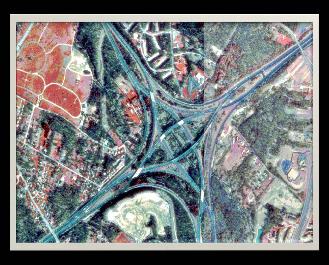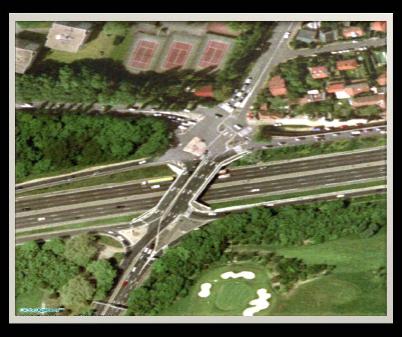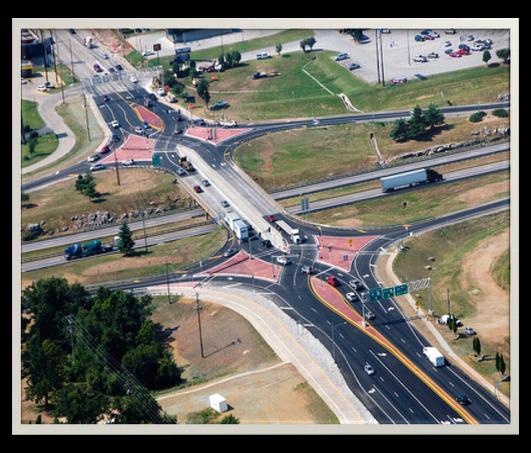In the Fall of 2000, Gilbert Chlewicki, currently ATS/American’s division director, but back then a first semester graduate student at the University of Maryland, College Park was beginning his graduate work for a master's degree in transportation engineering. In one of his classes, Chlewicki needed to write a term paper on any transportation related topic. Chlewicki had been drawing sketches of highways since he was in elementary school, developing many unique designs. He decided that he wanted to develop a new design and write a term paper on that design.
Chlewicki thought about how some intersection designs come from interchange concepts. The most prime example is the jughandle, which is most common in New Jersey. The jughandle takes the concept of using an interchange ramp to replace a direct left at an intersection. So Chlewicki started to look at interchanges in Maryland to determine if any of them could be converted into an at-grade concept.
 A
unique interchange existed where I-95 meets I-695 on the northeast side
of Baltimore. From any direction (the design is symmetrical on
all sides), as the highway enters the interchange, a right exit is
provided for the "right turns". Then the highway crosses over or
under the opposing traffic of the same highway, so that traffic is
now on the left side of the road. After the crossover, a direct
left exit is given for the "left turns". The highway then crosses
over or under both directions of the cross highway. It then
receives the "left turns" of the cross highway from a left entrance
ramp. After receiving this traffic, the highway crosses over or
under the opposing highway of the same highway again to get on the right
side of the road. Lastly, the highway receives the "right turns"
from the cross highway.
A
unique interchange existed where I-95 meets I-695 on the northeast side
of Baltimore. From any direction (the design is symmetrical on
all sides), as the highway enters the interchange, a right exit is
provided for the "right turns". Then the highway crosses over or
under the opposing traffic of the same highway, so that traffic is
now on the left side of the road. After the crossover, a direct
left exit is given for the "left turns". The highway then crosses
over or under both directions of the cross highway. It then
receives the "left turns" of the cross highway from a left entrance
ramp. After receiving this traffic, the highway crosses over or
under the opposing highway of the same highway again to get on the right
side of the road. Lastly, the highway receives the "right turns"
from the cross highway.
Aerial photo of the I-695 / I-95 interchange that existed to the northeast of Baltimore, Maryland
Chlewicki wanted to see what would happen in this interchange concept if all the grade separated bridges were replaced with at-grade intersections controlled by a traffic signal. The design looked promising, but Chlewicki felt that the real test of the design would be if it was possible to guarantee green lights throughout the design once the driver received the first green light. For this design, Chlewicki determined that it would only be possible to synchronize the thru movements for each roadway and even this was only possible if the split of green time for both directions were nearly identical.
 Failing
to think of a location where Chlewicki thought that this at-grade
design could be used, he decided to modify the design a little by
"untangling" one of the roadways, so that only one of the roadways would
have the crossover maneuvers. Chlewicki felt that this design was
even more promising since the synchronization of the signals could
be accommodated for all the movements including left turns. He
decided to call this design th
Failing
to think of a location where Chlewicki thought that this at-grade
design could be used, he decided to modify the design a little by
"untangling" one of the roadways, so that only one of the roadways would
have the crossover maneuvers. Chlewicki felt that this design was
even more promising since the synchronization of the signals could
be accommodated for all the movements including left turns. He
decided to call this design th e "criss-cross intersection".
e "criss-cross intersection".
Having another modification from the original interchange concept, Chlewicki was curious if an additional modification could be made to convert this new design into an interchange. The modification that Chlewicki decided to make was to grade separate the intersection where the roadways would meet each other. By grade separating this intersection and adjusting the right turns from the intersection design to form ramps, Chlewicki came up with the interchange design that he called the "criss-cross interchange". Chlewicki wrote the term paper on these two concepts.
The
next semester, Chlewicki wanted to further explore these designs.
His advisor suggested that while studying these designs, you might want
to rename these designs to something more technical since the names
sounded like the 80's pop singer Christopher Cross made these
designs. So Chlewicki renamed the intersection design the
"synchronized split-phasing intersection" (SSP) since the design has
features that you would see at a split-phased intersection but both
sides could have the green at the same time with the benefit of
synchronization additional signals. He renamed the
interchange the "diverging diamond interchange" (DDI) due to the
multiple diverging points throughout the interchange.
 At
the end of the spring semester, Chlewicki went to Seville, Spain to
visit his sister who was studying there for the semester and then to
tour Europe with his sisters. His last stop on his month-long tour
was Paris, France. While there, he took an excursion to the
Palace of Versailles. As his tour bus left the highway to get to
the palace, Chlewicki noticed that they were entering his diverging
diamond design. He got up in total amazement and shock. He
was so happy that the concept he came up with was actually good enough
to be in use, but he was a little disappointed that his idea was not
original after all.
At
the end of the spring semester, Chlewicki went to Seville, Spain to
visit his sister who was studying there for the semester and then to
tour Europe with his sisters. His last stop on his month-long tour
was Paris, France. While there, he took an excursion to the
Palace of Versailles. As his tour bus left the highway to get to
the palace, Chlewicki noticed that they were entering his diverging
diamond design. He got up in total amazement and shock. He
was so happy that the concept he came up with was actually good enough
to be in use, but he was a little disappointed that his idea was not
original after all.
Autoroute de Normandie (Highway A13) @ Boulevard de Jardy DDI in Versailles, France
With Chlewicki confident that the theory behind these new designs was sound, it was important for him to find a test location to simulate each design to see if there were any flaws to his theory. He also wanted to see if there was a real life application in the United States. Chlewicki tested both designs with real traffic volumes at selected locations in Maryland and did a comparison with the existing design. To his amazement, both designs exceeded his expectations in terms of how well the traffic operated.
Chlewicki wrote a paper entitled "New Interchange and Intersection Designs: The Synchronized Split-Phasing Intersection and the Diverging Diamond Interchange". He presented this paper to the 2nd Urban Street Symposium in Anaheim, California in July 2003.
Several people were impressed with the presentation while others were skeptical. One person who was impressed was Joe Bared, PhD, PE from the Federal Highway Administration (FHWA). Bared has specialized in investigating new geometric designs at FHWA and saw potential in these designs. So Bared went back to FHWA after the conference and started to examine these designs even more.
The
first study evaluated the DDI and SSP (which Bared renamed in his
paper the double crossover intersection or DXI) under a high, medium,
and low volume scenario. The results were even more promising.
Both the DDI and DXI had significant improvements over
conventional designs at high volumes. This paper came out in
2005.
A few transportation departments across the country
started to discover the DDI concept and started to explore it. It
appeared that the first possible DDI to be constructed in the United
States was going to be in Findlay, Ohio at I-75 and US 224. It was the
leading alternative until the final selection, when a different
alternative was selected. It appeared that the final decision was based
on safety concerns for an unproven design, which is a common fear for
new designs.
The next leading candidate for constructing a DDI
was in Kansas City, Missouri at the I-435 / Front Street
interchange. At the same time, FHWA wanted to study the safety
aspect of the DDI, so that a diverging diamond alternative would not be
rejected over safety concerns. At this point, FHWA abandoned studying
the SSP further as it appeared they were concerned about the complexity
of the design. For the study, they used their Highway Driving
Simulator to evaluate the DDI. They used the I-435 / Front Street
design as their sample interchange in the study. FHWA found that drivers
were intuitively able to maneuver within the DDI and find the path to
their intended destination. The biggest initial concern was wrong
way movements at the crossover areas. The study showed that this
concern was not warranted. FHWA was convinced that the DDI would
be safer than a conventional diamond interchange.
The Kansas
City DDI was anticipated to be completed in 2008 and be the first DDI in
the United States. This project showed that the DDI was
by far the superior alternative to any other design being considered.
The traffic operations were significantly better and now they were
convinced that the design would be safer. Perhaps the biggest
advantage of the DDI was that the cost was significantly less than the
other alternatives. The cost estimate for the DDI was about 40% less
than the conventional diamond and almost 75% less than the single point
urban diamond option. Unfortunately, there have been several
delays that have prevented this project from being constructed.
Meanwhile,
with the powerful study that was done by FHWA endorsing the safety of
the DDI, more agencies were examining implementing a DDI. The
design was starting to get very popular in pocket communities because of
all the potential advantages. It was anyone’s guess where the
first DDI might be built in the United States. The answer came as
an unexpected surprise.
Don Saiko, PE, who is a project manager
in the Springfield, Missouri District of MODOT, got word of the DDI
concept and wanted to investigate the design in the Springfield area.
He got permission to test the design at I-44 and Kansas Expressway
(SR 13) which had been experiencing tremendous traffic problems and
safety issues due mainly to the small left turn storage areas to the
ramps. A $10 million budget was given for the construction of this
project. Th e
simulations for the design looked very promising to fix the traffic and
safety problems. It was also a very cost effective solution.
The DDI was only going to cost about $3 million, saving the state
$7 million of the budgeted cost, which would have been the cost for a
conventional diamond solution. The design was going to be able to use
the existing bridge that had five lanes on the bridge with no sidewalks
and convert it to a DDI with four lanes on the bridge and a very wide
sidewalk in the median. Because no major construction was needed
on the bridge, the construction time was only going to take 6 months
instead of two years with the other options. The design plans were
approved and construction started in January 2009.
e
simulations for the design looked very promising to fix the traffic and
safety problems. It was also a very cost effective solution.
The DDI was only going to cost about $3 million, saving the state
$7 million of the budgeted cost, which would have been the cost for a
conventional diamond solution. The design was going to be able to use
the existing bridge that had five lanes on the bridge with no sidewalks
and convert it to a DDI with four lanes on the bridge and a very wide
sidewalk in the median. Because no major construction was needed
on the bridge, the construction time was only going to take 6 months
instead of two years with the other options. The design plans were
approved and construction started in January 2009.
Aerial
photo of I-44 / Kansas Expressway Diverging Diamond Interchange in
Springfield, Missouri. Photo from Missouri Department of
Transportation.
Very few transportation professionals knew of this project outside of the district office until the construction was nearly complete. The project was completed on time and within budget, with the DDI configuration opening on June 21, 2009 and the ribbon cutting ceremony for the completion of the project on July 7, 2009. The DDI has been a huge success at this interchange and is arguably performing even better than the simulation models indicated. The success of this design has spurred even more agencies to examine and build the DDI. The DDI is starting to get very popular as a possible cost-effective transportation solution.
Contact ATS/American for an interactive presentation on the DDI, which includes more history of the design and why it is gaining popularity.